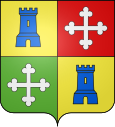Perrignier
| Perrignier | ||
|---|---|---|

|
|
|
| region | Auvergne-Rhône-Alpes | |
| Department | Haute-Savoie | |
| Arrondissement | Thonon-les-Bains | |
| Canton | Thonon-les-Bains | |
| Community association | Thonon agglomeration | |
| Coordinates | 46 ° 18 ′ N , 6 ° 27 ′ E | |
| height | 489-729 m | |
| surface | 7.85 km 2 | |
| Residents | 1,845 (January 1, 2017) | |
| Population density | 235 inhabitants / km 2 | |
| Post Code | 74550 | |
| INSEE code | 74210 | |
Perrignier is a French commune in the department of Haute-Savoie in the region of Auvergne Rhône-Alpes .
geography
Perrignier is located at 550 m , eight kilometers south-southwest of the city of Thonon-les-Bains (as the crow flies). The village extends in Bas-Chablais, in a hilly area shaped by moraines from the Ice Age Rhone glacier at the northern foot of the Savoy Prealps (Mont Forchat).
The area of the 7.85 square kilometer municipal area includes a section of Bas-Chablais. The plateau, which slopes slightly to the north, is drained by the Ruisseau du Redon and its source streams to the north to Lake Geneva . To the northwest, the municipality extends into the extensive forests of the Forêt de Planbois. In the northeast it extends to the hill La Maladière , on which the highest point of Perrignier is reached at 753 m .
Perrignier includes the hamlet settlements of Brécorens ( 540 m ) on the Ruisseau de la Gurnaz, Le Petit Lieu ( 540 m ), Fougueux ( 570 m ) and Le Villard ( 623 m ) on the southern slope of the Maladière. Neighboring communities of Perrignier are Margencel and Allinges in the north, Draillant in the east, Cervens in the south and Lully and Sciez in the west.
history
Some finds from the Neolithic suggest a very early settlement of the municipality. The Cistercian priory was founded around 1150, which was converted into an abbey ( Abbaye du Lieu ) in the 13th century and destroyed during the Bernese conquest in 1536. From 1974 to the end of 2000, Draillant also belonged to Perrignier. Since then it has been an independent community again.
Attractions
The village church of Perrignier dates from 1846, that of Brécorens was rebuilt from 1848 to 1851. The church and some wall foundations have been preserved from the former abbey.
population
| year | Residents |
|---|---|
| 1968 | 664 |
| 1973 | 782 |
| 1999 | 1357 |
| 2006 | 1439 |
| 2017 | 1845 |
With 1,845 inhabitants (as of January 1, 2017) Perrignier is one of the smaller communities in the Haute-Savoie department. In the last few decades there has been a continuous strong growth in the number of inhabitants. Outside the old village center, larger single-family houses developed.
Economy and Infrastructure
Until well into the 20th century, Perrignier was a predominantly agricultural village. Today there are various local small businesses as well as construction and trading companies. An industrial and commercial zone has developed to the west of the municipality. Many workers are commuters who work in the larger towns in the area or in Thonon-les-Bains.
The village is located on the D903 connecting road from Saint-Cergues directly to Thonon-les-Bains. Other road connections exist with Sciez, Draillant and Cervens. In addition, the area is crossed by the Annemasse – Thonon-les-Bains railway line ; the train station is outside the village near the industrial district.
Web links
- Website about Perrignier (French)
